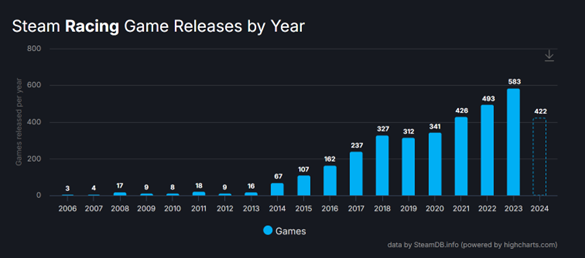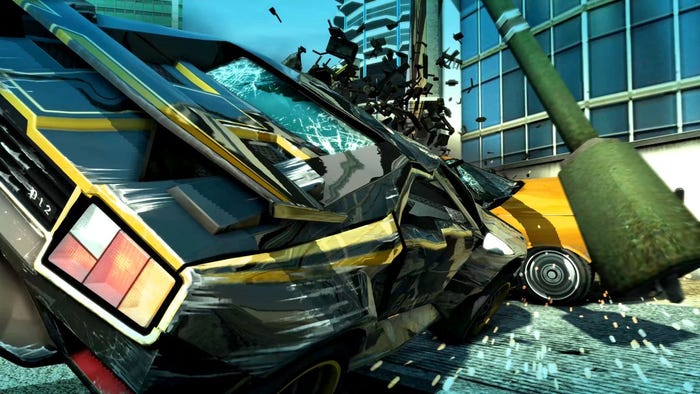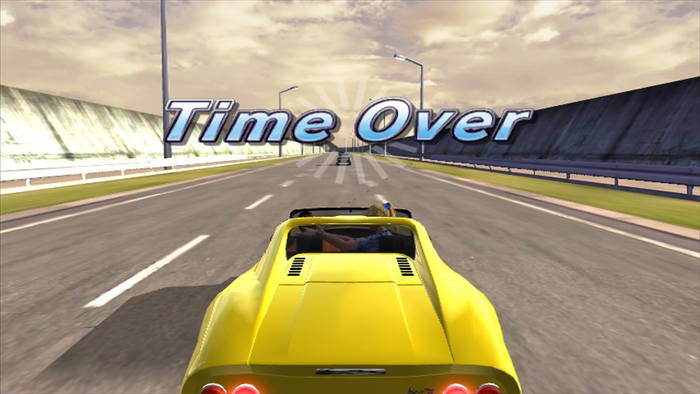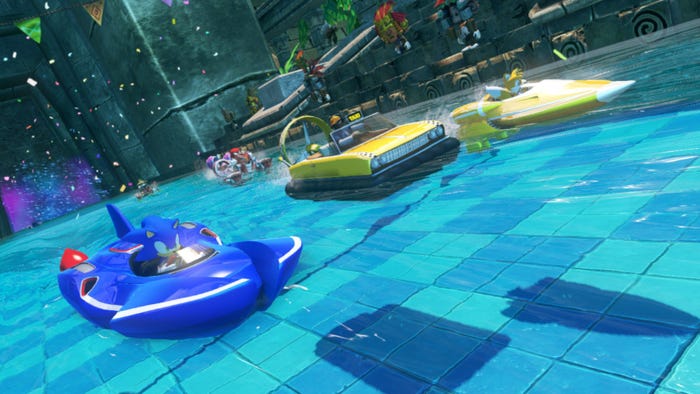Trending
Opinion: How will Project 2025 impact game developers?
The Heritage Foundation's manifesto for the possible next administration could do great harm to many, including large portions of the game development community.

Featured Blog | This community-written post highlights the best of what the game industry has to offer. Read more like it on the Game Developer Blogs or learn how to Submit Your Own Blog Post
Franchise development director at Sumo Sheffield Steve Lycett dissects the history of racing games and how developers can steer their games to success.
August 27, 2024
_(1).jpg?width=1280&auto=webp&quality=95&format=jpg&disable=upscale)
There is no feeling quite like getting behind the wheel of a really good racing game and hitting the track for the first time. Whether you’re a fan of realistic competitive racing, fast and furious chaos or breathtaking scenery and a good tune on the radio, racing games are one of the most flexible, adaptable and enduring genres of games.
It’s been over 50 years since players could first get into the virtual driver’s seat - with Atari’s Gran Trak 10 releasing in May of 1974 – the genre has only continued to rapidly accelerate, and never falls off the podium as one of the most popular genres on the market.
As Franchise Development Director at Sumo Sheffield, I know a thing or two about racing games. I've been working on racing games for over 27 years, with 21 of those spent at Sumo playing a key role on games including Outrun2, Outrun 2006: Coast2Coast, and Sonic & All-Stars Racing: Transformed.
So let's buckle in and get under the hood of what makes racing games so popular, their history, some key checkpoints in racing game history and how developers can steer games to success.
Do you ever find yourself driving on a smooth, open-road with no traffic, blue skies blaring and your favourite music blasting? No? Me neither! Most of us never get the opportunity to experience true freedom when driving… that is until we pick up our favourite driving or racing game.
Video games are the perfect medium when it comes to offering players a wide range of experience, to fulfil wishes and present them with a whole range of emotions in a safe environment. So while the real-world you might be stuck in bumper-to-bumper traffic, in-game you can make true those open-road cruising dreams.
This, combined with the fact that racing games offer relatively straight-forward gameplay which players intrinsically understand, have literally hundreds of different styles to choose from, and can scale in experience from the casual ‘pick up and play’ audience, right through to the highly dedicated progression-seekers, make racing games one of the most popular and enduring genres of games.

Captured in August 2024. This volume chart features racing games that were released onto Steam between 2006 and 2024. While the numbers might not be as dramatic as some of the top genres – like Shooters or Action and Adventure – they’re a good indicator that the genre continues to grow in popularity and scale.
And the games industry – which is usually ready to meet the demands of players head on – knows it. According to SteamDB, the rate at which racing and driving games are being released onto the platform has been slowly but surely increasing over the last decade: with just 68 being released in 2014, and 538 releasing in 2023. Whilst racing may not be overtaking the most popular genres, shooters and action-adventure, in releases, it still holds its own as a genre that entertains, thrills and even educates its players.
Our love of racing dates back to the very inception of the games industry, and I would argue has been one of the genres that is able to best showcase the power and capabilities of new hardware. Since Enduro launched for the Atari 2600 in 1983, we’ve seen a trend of games consoles having a racing game in their catalogue of launch titles, including the original PlayStation launching with Ridge Racer, the SEGA Saturn launching with Daytona USA, both the Xbox and Xbox 360 came with Project Gotham Racing incarnations – and of course the Wii U launch with Sonic & All-Star Racing Transformed! Each title is able to showcase increased speed, most responsive controls and stunning visuals better than any other genre, and can really push the envelope of the technical capabilities of a console.
Finally, style and flexibility is one of the major reasons video games continue to grow in popularity. Whether you’re wanting a hyper-realistic simulation experience that can see you climb the ranks and drive realistic cars around real-world tracks, if you want multiplayer chaos where you can betray your family and friends to win the trophy, or if you just want to cruise around and explore scenery and environments, there’s a racing game to suit you.

There’s something about the sunshine – a still from the world of Outrun 2006: Coast2Coast. From the hyper-realistic, to cartoon kart-racers… and everything in between, racing games as a genre offers a wide variety of styles, gameplay mechanics and features so there’s something for everyone to enjoy.]
I’ve worked in the games industry for a long time, and have borne witness to lots of major releases that shaped and evolved the way audiences engage with games, the way they’re made and the way they’re received by the world. Unsurprising, then, that many of these titles sit within or adjacent to the racing genre – with classics that were immediate hits, ones that have gone on to spur long-standing franchises or ones that have been lost to time but remain hugely popular.
Here are some of the biggest moments in racing game history that, in my opinion, changed the game for developers:
Pole Position (1982) – Defining the Template:
Whilst Pole Position was by no means the first arcade racing game, it defined the template for many that followed. First the low down, but wide field of view camera to give that sense of speed, the lo/hi shifter, plenty of rivals to race and the worse enemy of all, time! Add bright colourful graphics, high quality sound (and speech!) and it was an instant arcade hit. Quite the achievement given the technology available at the time – and the great grandparent of many racing games that we know today.
OutRun (1986) – Digital Wish Fulfilment:
Well, you know we must mention this one! Instead of racing circuits, now we’re on a journey driving into the sunset in a Ferrari Testarossa with our best girl at our side. OutRun was an amazing road trip, the Cannonball Run powered by SEGA’s Super Scaler technology. Pick your favourite tune (Splash Wave, of course!) and take to the road, which - for the first time - allows you to pick which way to head at the end of each stage. Visually, aurally and physically, OutRun was an instant classic and changed driving games forever.
Super Mario Kart (1992) – Family Fun with Comfortable Characters:
Our moustachioed hero and his colourful cast of characters were going to end up on this list somewhere, so we might as well go back to where it all began. From its 16-bit beginnings for the SNES, to the ultra-polished, IP-incorporating behemoth franchise it’s become over time. Mario Kart has always been popular and has had a history of becoming a key title for each new generation of Nintendo console. What Mario Kart provides is fast family fun which brings people together, with interesting gameplay mechanics, fun power-ups and a comforting, familiar set of characters to play with, all whilst offering multiplayer or single-player campaign where dedicated players can grow their skills. Each new game that releases improves and builds upon its speed, handling, adds new tracks and characters, and brings back retro ones to play on our sense of nostalgia.

Virtua Racing completely refreshed the way racing games were made – bringing a cartoon art style into 3D worlds which players could experience from four different angles… and let’s not forget that all-important blue sky!
Virtua Racing (1992) – The Dawn of the Polygon Age:
Launching in the very same month, Virtua Racing appears in arcades and racing games will never be the same again. We move from 2D into full 3D, and you can now choose to race from one of four camera positions, all designed to show off the fast, high-resolution graphics and one of the first arcade games to run on 16:9 screens too! Add incredible engine sounds and SEGA’s classic musical jingles – plus some of the best blue skies in the business – and suddenly all other racing games looked old fashioned. Visually it might have inspired Sumo’s own Hotshot Racing…
Ridge Racer (1993) – Pioneering Drifting as a Core Mechanic
A year later and we see a technological arms race between Namco and SEGA to produce the most realistic 3D graphics. Ridge Racer adds textures and Gouraud shading to the mix, but it’s the gameplay that’s the star. Tap the brake as you enter the turn and you can trigger one of the most satisfying drifts around corners and used well, slice seconds off your lap times. Musically we’re bang up to date with some rather techno inspired tunes to race too. Of course, just two years later Ridge Racer is a PlayStation launch title and consoles begin to overtake the arcade in terms of innovation…!
Gran Turismo (1997) - Bringing Real-World Cars to the Gaming World:
Taking everything people loved about arcade-style racers, combining it with simulation experience and bringing it into people’s homes, Gran Turismo was truly unique upon its release. The game offers a high level of realism when it comes to car physics and appearance, graphics and track detail – with Silverstone, Nürburgring and Le Mans all appearing with delightful accuracy – and lets players collect credits, progress their skills and win trophies and prizes. Although it wasn’t the first to introduce licensed cars to the video game world, Gran Turismo built upon and expanded the concept, and featured the Aston Martin V8 Vantage, the 1967 Chevrolet Corvette and the Dodge Viper… now who wouldn’t want to take those for a spin?

A screenshot from the 2018 remaster of Burnout Paradise. Instead of getting players to focus on great driving skills, Burnout brought a new dynamic to the racing genre in encouraging players to cause as much damage and chaos as possible.
Burnout (2001) – It’s Good to Be Bad:
When players loaded into Burnout back in the early 00s they were surprised to find that its focus was not about smooth driving techniques and skills on the track, but were instead challenged to tackle traffic, junctions and obstacles in their races. Seemingly, these are all things we’re actively looking to escape in our real-world driving experiences… but what separated Burnout from the rest was its over-the-top action and dramatic crashes! Its successor, Burnout 2: Point of Impact introduced a separate ‘Crash’ mode where players had to cause as much damage as possible in the time limit. This was revolutionary for the genre and has become the defining feature of the series through the years.
Project Gotham Racing 2 (2005) - More players = More fun!
Technically the third game in the series (as it started life as Metropolis Street Racer on the Dreamcast), PGR 2 took the already great ingredients of real-world cities, an amazing stable of cars and the sublime Kudos system (drive with style!) and added online play throughout. Using Xbox Live meant players could race against anyone in the world (and trade trash talk, of course) or battle asynchronously for leaderboard positions… and it even added DLC in later years which featured new cars and cities for players to challenge upon. Later incarnations polished this formula further, but PGR2 set a definite new bar for all games that followed.

Outrun 2006: Coast2Coast is one of the most fun games I’ve worked on during my careers. We had the opportunity to faithfully adapt the original, arcade machine version and bring new features to it… including my personal favourite: “Don’t Lose Your Girlfriend”, which introduced a risk-reward dynamic not seen before in the game.
Outrun 2006: Coast2Coast (2006) – Introducing the Slipstream System
Of course, I was always going to include one of my all-time favourite games not only to work on, but to play. When we spoke to SEGA about bringing Outrun 2006: Coast2Coast from arcade machines to the living rooms of players, we were tasked with maintaining the ‘arcade feel’, high-speed driving, stunning visuals and all the fun of the original, while adding our own missions, level design and flair. Whilst we built upon the work we’d done on Outrun2 just two years earlier, Coast 2 Coast saw us really get comfortable with the IP and introduce things we felt fit the franchise, including a structured gameplay experience and a progression system, more cars, new modes, online play and the introduction of the slipstream system which can be found in modern-day racing games. It challenges and rewards players in equal measures, and I still think it’s as bright, colourful and genuinely fun to play as it was all those years ago. Oh and we squeezed it into a PSP so you could play it on the go too!
Forza Horizon (2012) – Hitting the Open World:
The Forza Horizon series offers players everything we long for in driving: big, beautiful and explorable environments, a wide range of licensed cars and an all-round great atmosphere and vibe. I truly believe that this open-world game took all of the lessons of the titles that came before it and built upon them to create a truly unique and engaging game which has gone on to span sequels and spin-offs, all of which keep evolving and enhancing. Players can take part in a myriad of race-types, including circuit, off-road and traditional, but also have the opportunity to buckle up and head into the vast landscape created for them. You can see how Forza Horizon built further on Microsoft’s experience from the PGR and Forza Racing series with successful content updates, strong engaging with its community and raised the bar even higher for the genres’ future in live service.

Is it a plane? Is it a boat? Is it a car? YES! Sonic & All-Stars Racing Transformed made popular the transforming tracks concept, and ensured players had more to look at than just the main race whenever they played. Look out for flying dragons, jumping whales and battling ships adding to the chaos of this colourful kart-racer.
Sonic & All-Stars Racing Transformed (2012) – Transforming Tracks
OK, sorry, self-indulgence for one last time, but this is still my favourite released game and one where we took all our previous racing game experience to push the genre forward in ways players wouldn’t expect! What if your car could transform into a boat or a plane? What if we mixed our favourite SEGA characters and worlds? What if you could ride a mechanical turtle on a race set on lava? Well, Transformed answered all those questions! We crammed in as much SEGA as was legally allowed into one massive love letter to racing game fans and even managed to sneak in a bonus OutRun2-themed track! Plus what other game lets you race as a Dreamcast controller? Let’s not forget it was also Wii U launch title with five-player split screen play!

Audio plays a huge role in creating a great racing game with a combination of authentic car audio, ambient road noise and, of course, some really great music. Encapsulating all of these is driving-adjacent game, Grant Theft Auto - the radio stations of which have become something of legend. In 2023, Spotify launched ‘Grand Theft Auto Radio’ which pulls hidden gems and classics from your favourite artists across all genres, as if they were tracks on the GTA Radio Stations.
For me, the best thing about working on racing games is that they are genuinely fun to make – the unpredictability of the races, the visuals and the joy of getting to speed around means playtesting is always fun, and we’re always looking for new ways to push the boundaries of what can be done.
In my experience, there are a few core elements that can supercharge a racing game and take it from third place to champion. Here are some of my top tip to any developers planning to write their own racing game…
Get the Sense of Speed Right: In any racing game, you need give players a breadth of speeds and they all have to feel authentic and accurate. No one wants to be going full-throttle on the controller, only to find that their car is idling along at 30. To do this, make sure the camera is low and wide so you can get a sense of speed and movement, and create audio that sounds like the engine is always accelerating – even if you’re already going at top speed. If it looks fast and sounds fast, then you’re most of the way there.
Don’t Underestimate Audio: You might think that the primary focus of racing games is all about the visuals, but a lot of audio work needs to happen to immerse players into the action. Not only does the SFX for vehicles have to feel authentic and empowering, but the environmental sound needs to reflect actions of the player, and – of course – the music has to add to the pacing of the game… Listening to piano sonatas in the final round of a cup series is not conducive to a winning environment!
Implement a Learning Curve: Most racing games have a purity to them that makes them accessible for anyone at any skill level to pick up and play, and the ones that have continued to endure are those that give players the option to go on a learning curve and grow their skills. This grants players the opportunity to play their way – some want to race around in a social setting and just have fun, others want to learn the tracks and mechanics, and perfect their techniques... and be rewarded for doing so.
Physics and Handling: Regardless of the type of racing game you’re making – whether it be sim, arcade sim or realistic experience – players have to feel like they are in control. Having solid, predictable responses to the impact of a player, depth in how a vehicle behaves in a variety of situation, or how upgrades/customisation change the behaviour of a vehicle will encourage players to keep playing, building and growing. And, regardless of style, if you can capture the handling feel of different models and types of cars, you’re giving the player the opportunity to get behind the wheel of some of their favourites – a key draw of why people love to play them!

Games like Forza Horizon 5 take environments to a new level and give players an open-world experience, where they can encounter breathtaking scenery and stunning visuals. Another world from the congestion of our every day commutes. As technology continues to evolve, developers are able to create even more spectacular graphics which elevate environment from the background, to a key part of the experience.
Environments: The euphoric feeling of driving along beautiful roads laden with stunning scenery and panoramic views is one I personally love to get from a racing game. But whether your game is an open-road driving experience, or a tight, on-track trial, it’s important to get the environment surrounding the action right. It has to be the right balance between ambient and unobtrusive, with lots of fine-tuned details for the optimal driving experience – from the weather to the width of the road!
Capturing Competition: Part of the appeal of racing games is the desire to perform well and win. Ways to do this include having strong social mechanics, so players have the opportunity to share their wins with the world, offering plenty of achievements to be earned, or to have collectables or unlockables for players to pick up and discover. Those, combined with progression and variety, form a great foundation for a racing game.
---
Racing games always have and always will have a huge impact on the wider games industry. Many features present in racing games have evolved to fit other genres: vehicle-based transportation (horses count!) and combat, driving mechanics, time trials… the list goes on!
It’s been a long road over the last 50 years for racing games and developers have learned plenty of lessons and honed their craft when it comes to creating experiences for players. As someone who has watched the genre grow throughout my career, it’s heartwarming to see not only that developers keep finding ways to make them fresh and relevant, but that players continue to welcome them with open arms.
You May Also Like